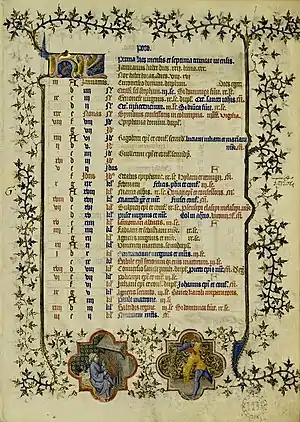Golden number (time)
A golden number (sometimes capitalized) is a number assigned to each year in sequence which is used to indicate the dates of all the calendric new moons for each year in a 19-year Metonic cycle. They are used in computus (the calculation of the date of Easter) and also in Runic calendars. The golden number of any Julian or Gregorian calendar year can be calculated by dividing the year by 19, taking the remainder, and adding 1. (In mathematics this can be expressed as (year number modulo 19) + 1.)

For example, 2021 divided by 19 gives 106, remainder 7. Adding 1 to the remainder gives a golden number of 8.
The golden number, as it was later called, first appears in a calendar composed by Abbo of Fleury around the year 1000. Around 1162 a certain Master William referred to this number as the golden number "because it is more precious than the other numbers."[1] The term golden number became widely known and used, in part through the computistic poem Massa Compoti written by Alexander de Villa Dei around 1200.[2]
References
- Nothaft, C. Philipp E. (2018), Scandalous Error: Calendar Reform and Calendrical Astronomy in Medieval Europe, Oxford: Oxford University Press, pp. 57–58, ISBN 978-0-19-879955-9
- Walter Emile van Wijk, Le Nombre d'Or: Étude de chronologie technique suivie du texte de la Massa Compoti d'Alexandre de Villedieu (The Hague: Martinus Nijhoff, 1936) — online link.
- "Metonic Cycle". Microsoft Encarta Online Encyclopedia. Archived from the original on October 31, 2009.